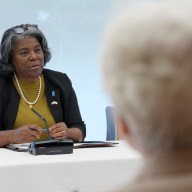
You don’t have to have a body like Usain Bolt to make it in the golf world, but that doesn’t give you permission to let yourself go. “The execution of the golf swing, there’s a physical component to it as well as a swing component,” says Sean Cochran, Phil Mickelson’s personal trainer. “There are requirements of flexibility, mobility, stability and strength in order to execute the golf swing or improve the golf swing.”
At Friday’s U.S. Open, we caught up with Cochran in the American Express Championship Experience tent, where he gave us the lowdown on how the championship player prepares himself to excel on the course.
The three-pronged approach
No. 1: Assess the situation
“What we do is we look at how is the body operating via the requirements of the swing,” Cochran says. “For example, we know that the hips have to rotate a certain amount, the upper body has to rotate a certain amount; I need a certain level of hamstring flexibility, I need a certain amount of core strength. So we’re gonna take them through a series of assessments, and they have to be within certain parameters in order to execute the swing. If they’re outside the parameters then we’re gonna give them some exercises to get them inside, or what’s required of the golf swing.”
No. 2: Work the hips
“The hips are a ball-and-socket joint, so they should rotate a lot,” he says. “Oftentimes we find the muscles around the hips are tight, so what we do is stretch the muscles around the hip to get more mobility. A kneeling hip flexor stretch would be one example.”
No. 3: Strengthen the core
“When we talk about the core, that’s all the muscles on the front, sides, back of the body — it’s this big area,” Cochran says of the misleading thought that the abs are what make up the core. “We often call that the engine of the golf swing, so we’re gonna give exercises for all [of it].” Cochran says it’s difficult to find one exercise that trains everything at once, so you’ll need to do a few in order to get the whole area strong. “Planks are very common and very fundamental for the front side of the core. We can do what we call a glute bridge, which focuses on the lower back and the glutes: You’re on [your back], knees are bent and your hips are off the ground. And then we can do some rotary work for [obliques]: I can take some tubing and do some tubing rotations, so I’m engaging the core and then I’m engaging it in a rotary pattern, which is very similar what it does in the golf swing.”
How Mickelson has improved
“Ten years ago, what I found is that he was very flexible in the lower body but not so much in the upper body. So we needed to get him more mobile in the upper body, and in addition to that, as we progressed, we’ve gotten him stronger in the core, stronger in the lower body and he’s definitively increased his swing speed.”
How he did it:
Stretching
“It’s very common stretches that a lot of people do. We could do hands on top of the [exercise] ball and stretch the lats. We’ll do a frontal shoulder stretch. We can use the foam roll. And then relative to core strength, we did exercises I just described and then more advanced ones with the exercise ball, like physioball crunches, leg curls on the physioballs, Russian twists. The majority of the speed work we do is more rotary speed work with the medicine ball, like medicine ball throws.”
Paying attention to nutrition
“If you have a race car and you give it bad gas, it’s not gonna run too well. The same can be said for any athlete,” Cochran says. “If they’re not putting good food in their body, the fuel they’re putting in their system is gonna be bad and you’re not gonna perform as well as you potentially could.” Mickelson has a personal chef, but that doesn’t excuse him from watching what he eats: “He is actually very astute in his nutrition now — over the years he’s learned,” Cochran says. “He eats a lot of fish these days, a lot of vegetables, salads, some complex carbs such as yams or things of that nature.”
Drinking (lots of water)
“People don’t realize that for your average tour player, through four rounds of golf, every round is gonna be anywhere from four to six miles of walking. So if you do a Thursday through Sunday event, that’s anywhere from 16-25 miles. That’s a lot of walking in a four-day period.”
Tackling the physical before the mental
Golf is very much a mental game, and Cochran says he leaves that training to other professionals. But he does think that an in-shape body is the first building block. “In order to be mentally focused and execute what you want it to do, you need to have a body that can physically execute what you want to do. Once I have the physical foundation built then I can hand it off to those professionals. There’s a whole plethora of sports psychologists that do that. I stick within what I know.”
















